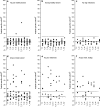Spontaneous T-cell responses against peptides derived from the Taxol resistance-associated gene-3 (TRAG-3) protein in cancer patients
- PMID: 15580499
- PMCID: PMC11032900
- DOI: 10.1007/s00262-004-0578-9
Spontaneous T-cell responses against peptides derived from the Taxol resistance-associated gene-3 (TRAG-3) protein in cancer patients
Abstract
Expression of the cancer-testis antigen Taxol resistance-associated gene-3 (TRAG-3) protein is associated with acquired paclitaxel (Taxol) resistance, and is expressed in various cancer types; e.g., breast cancer, leukemia, and melanoma. Thus, TRAG-3 represents an attractive target for immunotherapy of cancer. To identify HLA-A*02.01-restricted epitopes from TRAG-3, we screened cancer patients for spontaneous cytotoxic T-cell responses against TRAG-3-derived peptides. The TRAG-3 protein sequence was screened for 9mer and 10mer peptides possessing HLA-A*02.01-binding motifs. Of 12 potential binders, 9 peptides were indeed capable of binding to the HLA-A*02.01 molecule, with binding affinities ranging from strong to weak binders. Subsequently, lymphocytes from cancer patients (9 breast cancer patients, 12 melanoma patients, and 13 patients with hematopoietic malignancies) were analyzed for spontaneous reactivity against the panel of peptides by ELISpot assay. Spontaneous immune responses were detected against 8 epitope candidates in 7 of 9 breast cancer patients, 7 of 12 melanoma patients, and 5 of 13 patients with hematopoietic malignancies. In several cases, TRAG-3-specific CTL responses were scattered over several epitopes. Hence, no immunodominance of any single peptide was observed. Furthermore, single-peptide responses were detected in 2 of 12 healthy HLA-A2(+) donors, but no responses were detectable in 9 HLA-A2(-) healthy donors or 4 HLA-A2(-) melanoma patients. The identified HLA-A*02.01-restricted TRAG-3-derived epitopes are targets for spontaneous immune responses in breast cancer, hematopoietic cancer, and melanoma patients. Hence, these epitopes represent potential target structures for future therapeutic vaccinations against cancer, possibly appropriate for strategies that combine vaccination and chemotherapy; i.e., paclitaxel treatment.
Figures




Similar articles
-
Spontaneous CD4+ T cell responses against TRAG-3 in patients with melanoma and breast cancers.J Immunol. 2006 Aug 15;177(4):2717-27. doi: 10.4049/jimmunol.177.4.2717. J Immunol. 2006. PMID: 16888034
-
Identification of HLA-A*0201-restricted cytotoxic T lymphocyte epitope from TRAG-3 antigen.Clin Cancer Res. 2003 May;9(5):1850-7. Clin Cancer Res. 2003. PMID: 12738743
-
Recognition of HLA-A2-restricted mammaglobin-A-derived epitopes by CD8+ cytotoxic T lymphocytes from breast cancer patients.Breast Cancer Res Treat. 2004 Nov;88(1):29-41. doi: 10.1007/s10549-004-8918-1. Breast Cancer Res Treat. 2004. PMID: 15538043
-
The Tübingen approach: identification, selection, and validation of tumor-associated HLA peptides for cancer therapy.Cancer Immunol Immunother. 2004 Mar;53(3):187-95. doi: 10.1007/s00262-003-0480-x. Epub 2004 Jan 31. Cancer Immunol Immunother. 2004. PMID: 14758508 Free PMC article. Review.
-
Hierarchy, tolerance, and dominance in the antitumor T-cell response.J Immunother. 2001 May-Jun;24(3):193-4. J Immunother. 2001. PMID: 11394495 Free PMC article. Review. No abstract available.
Cited by
-
Strength in numbers: achieving greater accuracy in MHC-I binding prediction by combining the results from multiple prediction tools.Immunome Res. 2007 Mar 24;3:5. doi: 10.1186/1745-7580-3-5. Immunome Res. 2007. PMID: 17381846 Free PMC article.
-
A phase 1/2 trial of an immune-modulatory vaccine against IDO/PD-L1 in combination with nivolumab in metastatic melanoma.Nat Med. 2021 Dec;27(12):2212-2223. doi: 10.1038/s41591-021-01544-x. Epub 2021 Dec 9. Nat Med. 2021. PMID: 34887574 Free PMC article. Clinical Trial.
-
Therapeutic cancer vaccines in combination with conventional therapy.J Biomed Biotechnol. 2010;2010:237623. doi: 10.1155/2010/237623. Epub 2010 Jun 29. J Biomed Biotechnol. 2010. PMID: 20617155 Free PMC article. Review.
-
Improved Natural Killer cell activity and retained anti-tumor CD8(+) T cell responses contribute to the induction of a pathological complete response in HER2-positive breast cancer patients undergoing neoadjuvant chemotherapy.J Transl Med. 2015 Jun 27;13:204. doi: 10.1186/s12967-015-0567-0. J Transl Med. 2015. PMID: 26116238 Free PMC article. Clinical Trial.
-
Cancer treatment: the combination of vaccination with other therapies.Cancer Immunol Immunother. 2008 Nov;57(11):1735-43. doi: 10.1007/s00262-008-0480-y. Epub 2008 Feb 20. Cancer Immunol Immunother. 2008. PMID: 18286284 Free PMC article. Review.
References
-
- Andersen MH, thor Straten P. Survivin—a universal tumor antigen. Patholo Histopathol. 2002;17(2):669–675. - PubMed
-
- Andersen MH, Ostergaard Pedersen L, Becker JC, thor Straten P. Identification of a cytotoxic T lymphocyte response to the apoptose inhibitor protein Survivin in cancer patients. Cancer Res. 2001;61:869–872. - PubMed
-
- Baylin SB, Herman JG, Graff JR, Vertino PM, Issa JP. Alterations in DNA methylation: a fundamental aspect of neoplasia. Adv Cancer Res. 1998;72:141–196. - PubMed
Publication types
MeSH terms
Substances
LinkOut - more resources
Full Text Sources
Other Literature Sources
Research Materials

